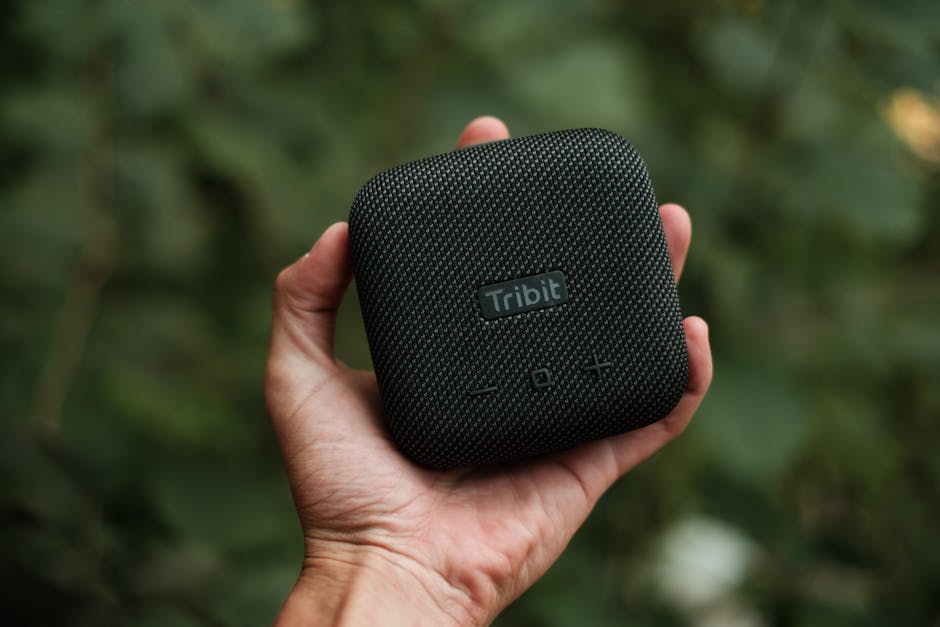If you’re shopping for a portable Bluetooth speaker, it’s a given that you want good sound. With a budget of $75-$150, there is no shortage of great options, including WIRED favorites like the JBL Flip 7, Beats Pill, and Tribit StormBox 2.
If your travel ambitions have already soaked up most of your cash, you have fewer choices. Spending less always involves a tradeoff, but Tribit’s StormBox Mini+ ($40) involves far fewer compromises than you might think, and it even throws in a few features the more expensive models lack.
I spent a week with the StormBox Mini+, using it as a backyard and travel companion, and I’ve grown quite fond of its versatility. I’d still recommend spending a bit more, but if that’s just not an option, this speaker won’t disappoint.
What’s the Plus?
Photograph: Simon Cohen
The StormBox Mini+ follows the now-familiar design formula popularized by JBL and Ultimate Ears (UE). Its cylindrical body is wrapped in wear-resistant fabric weave and capped at both ends with rubbery silicone. It comes in three colors: black, green, and blue.
If you’re familiar with the Tribit StormBox Mini, the Plus model is almost identical. It adds compatibility with the free Tribit companion app (which sports an equalizer and a few other settings), and introduces the AAC codec (for arguably better audio, especially on iPhones).
An IPX7 rating means it should survive immersion in water down to three feet for 30 minutes, but given that it floats (upside down), I doubt you’ll ever put that to the test. It certainly handled a bit of bobbing in my kitchen sink. Just keep in mind that the “X” in IPX means no dust resistance. Tribit says that sand grains are too big to be considered dust and thus not an issue, but I’m a bit skeptical of that claim.
Photograph: Simon Cohen
On the speaker’s spine, you’ll find backlit buttons for power/Bluetooth pairing/LED control. Then, on the front, embedded in the fabric grille are oversized volume controls, inspired, no doubt, by UE’s iconic Boom family of speakers. Like the UE speakers, you can pair two Stormbox Mini+ models for surprisingly good stereo sound, and the Bluetooth button on the back also serves to pair speakers. Unfortunately, connecting the 3.5mm aux-in port disables the Bluetooth connection, so no stereo pairing is possible when using an analog source.
Between the volume buttons is a multifunction button that controls playback and voice assistant access. You read that right: There’s a speakerphone for calls, or you can use the built-in mic to talk to Siri (or whoever responds on your particular phone). You won’t find that on any of JBL’s portables. Another feature you won’t find is the StormBox Mini+’s 3.5mm AUX input, which sits behind a protective rubber gasket. These ports are a rarity among all waterproof portable speakers. Tribit includes a USB-C charging cable, but no 3.5mm analog patch cable.
LED lighting seems to be everywhere these days, and the StormBox Mini+ has a small LED halo on top, with your choice of two music-synced patterns: breathing or blinking. These can be controlled (or disabled) by the Tribit app, or the dedicated button on the speaker’s spine. The light effects are fun, but what surprised me was how soothing I found the breathing pattern when no music was playing at all. It’s got a lava lamp-like charm.
Photograph: Simon Cohen
Speaking of that LED ring, Tribit has a bit of a missed opportunity on its hands: The StormBox Mini+ has no visual indicator for volume level, and the only battery indication happens when the level drops to 20% or lower (the power button blinks). The LED ring could be used for both.y
Portable speakers should be portable, which means size and weight both matter. Measuring 4.69 x 3.58 x 3.58 inches (a hair taller than the 4.09 x 3.75-inch UE Wonderboom 4), the StormBox Mini+ should be easy enough to throw in a backpack or carry-on. However, at 1.3 pounds, it’s surprisingly weighty. By contrast, the Wonderboom 4 is only 0.9 pounds.
At that weight, the StormBox is roughly the same as JBL’s more powerful Flip 5 (1.2 pounds), which you can still buy on Amazon for $80. My point isn’t that it’s too heavy, it’s that if weight is more important to you than things like battery life and sound quality, it might be worth looking at ultra-portables like Soundcore’s Select 4 Go ($25/9.8 ounces), JBL’s Go 4 ($50/11 ounces).
Surprising Sound
Thanks to its two 48mm drivers, the StormBox Mini+ can reproduce stereo sound. Realistically, because the drivers are horizontally opposed, you’re never going to get true stereo separation. But don’t worry about that; it’s nearly impossible for any speaker of this size to do true stereo. What you do get is 360 degrees of sound dispersion. Place it in the middle of a room or garden and there isn’t a bad seat in the house.
It can’t quite match the midrange clarity of UE’s Miniroll ($80), and yet I didn’t find it lacking clarity. In fact, whether I played jazz classics, pop hits, or vocal-forward tracks, I was impressed by how well the compact speaker handled each genre.
Massive levels of volume aren’t in the cards for a speaker of this size, but unlike some portables I’ve tried, you can ramp the StormBox up to 100% with almost no distortion. At that level, you’ll easily annoy your neighbors. Battery life will also take a major hit when playing that loud, and the speaker will amusingly bounce itself around, yet it’s still a very enjoyable listen.
Likewise, you’ll have to keep your expectations in check when it comes to bass. Despite its festive LED light show, it’s not a party speaker. You’ll hear some lows, and if you place the speaker on a large surface like a non-marble kitchen counter, you may feel them. For its size, I have no complaints. Moreover, if you place the StormBox Mini+ in a corner or up against a wall, the boundary gain effect can offer significant bass enhancement.
Tribit’s newly added, app-based EQ function is worth experimenting with. The available nine-channel custom equalizer is overkill for such a small speaker, but I’ve got to hand it to Tribit: If you’re going to offer an equalizer, you need to let people save their favorite mixes, and this lets you save 15 of them. I had better luck with the five built-in presets (Music, Audiobook, Classical, Rock, and Jazz).
Stay Close for Calls
Photograph: Simon Cohen
The speakerphone function works well. That said, the gain on the built-in mic is a tad on the low side. If I moved further than about two feet from the speaker, my voice became a lot fainter. Other reviewers have tested the StormBox Mini+ for phone calls and noted that the speaker disconnected. I had no such problems. I also had no problem summoning Siri. A long press on the multifunction button was followed by two tones, one to confirm the long press and a second to let you know Siri was now listening.
Tribit claims you’ll get 12 hours of playtime on a single charge (you’ll need 2.5 hours to charge it from empty). If you keep the volume at 50% and turn off the LED ring, you’ll probably get pretty close to that number. In my testing, using a variety of volume levels (mostly above 50%), with the ring lit continuously, it was closer to 9.5 hours. These aren’t the best specs for a portable speaker, but given that you can get almost a whole day out of a charge, they aren’t a deal-breaker, either.
The StormBox Mini+ has no shortage of competitors in the portable Bluetooth speaker market. You can go smaller and less expensive with the Soundcore Select 4 Go, you can spend more for slightly better sound in UE Wonderboom 4, and the sky’s the limit for more powerful options, including the excellent JBL Flip 7 ($150), Ultimate Ears Megaboom 4 ($150), and Marshall Middleton ($320). However, I’d argue that for its unique combination of price, sound quality, and features, you’d be hard pressed to find another waterproof model that checks as many boxes.



